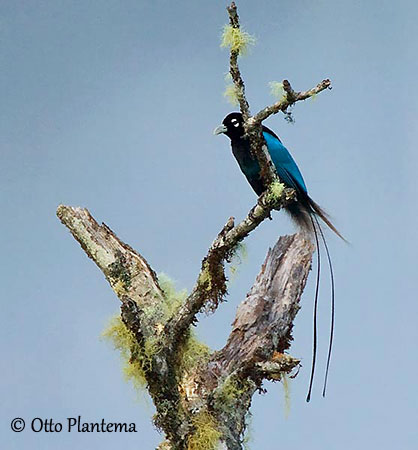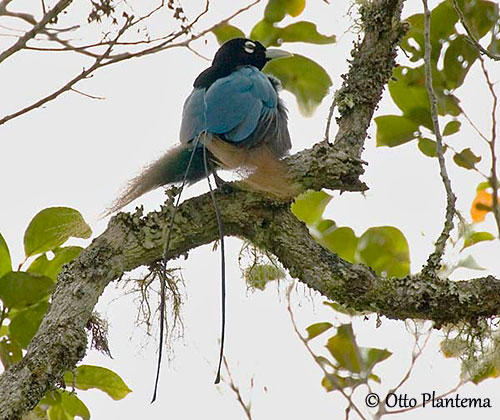
PROTECTION / THREATS / STATUS:
The Blue Bird-of-paradise is threatened by habitat loss caused by forest clearance due to the increasing human population.
But the second major threat is hunting of adult males for their plumes, especially pectoral and tail feathers. This is a traditional customary practice, but the birds are also locally hunted for consumption.
However, the international trade was stopped in the 1920s.
The Blue Bird-of-paradise is uncommon to rather rare, and it is also patchily distributed. The population size is unknown, but it is suspected to decline slowly. On the other hand, significant areas of its range are inaccessible and largely uninhabited, giving grounds for some good future for its survival.
The Blue Bird-of-paradise is currently classified as Near Threatened.
Fr: Paradisier bleu
Ang: Blue Bird-of-paradise
All: Blauparadiesvogel
Esp: Ave del Paraíso Azul
Ita: Uccello del paradiso azzurro
Nd: Blauwe Paradijsvogel
Sd: blå paradisfågel
Photographer:
Otto Plantema
Trips around the world
Text by Nicole Bouglouan
Sources:
HANDBOOK OF THE BIRDS OF THE WORLD Vol 14 by Josep del Hoyo-Andrew Elliot-David Christie - Lynx Edicions – ISBN: 9788496553507
Les Oiseaux de paradis – Histoire Naturelle et photographies - par Michel Ottaviani - Editions Prin, France – ISBN : 2-909136-40-X
Birds of Paradise and Bowerbirds De Phil Gregory – Editeur: Bloomsbury Publishing, 2020 – ISBN: 1472975847, 9781472975843 – 416 pages
Birds of New Guinea: Second Edition De Thane K. Pratt, Bruce M. Beehler – Editeur: Princeton University Press, 2014 – ISBN: 0691095639, 9780691095639 – 528 pages
Birds of New Guinea: Distribution, Taxonomy, and Systematics De Bruce M. Beehler, Thane K. Pratt – Editeur: Princeton University Press, 2016 – ISBN: 069116424X, 9780691164243 – 672 pages
Book of Curious Birds De Jennifer Cossins – Editeur: Hachette UK, 2021 – ISBN: 073442048X, 9780734420480 – 64 pages
Astonishing Animals: Extraordinary Creatures and the Fantastic Worlds They ... De Tim Flannery – Editeur: Open Road + Grove/Atlantic, 2012 – ISBN: 0802194176, 9780802194176 – 192 pages
Bird: The Definitive Visual Guide De DK – Editeur: Dorling Kindersley Ltd, 2022 – ISBN: 0241596319, 9780241596319 – 512 pages
CREAGUS@Monterey Bay (Don Roberson)
Fatbirder - The World’s Richest Information Resource about Birds for Birders
Wikipedia, the free encyclopaedia
Blue Bird-of-paradise
Paradisornis rudolphi
Passeriformes Order – Paradisaeidae Family
INTRODUCTION:
The Blue Bird-of-paradise is endemic to Papua New Guinea where it is found in central and eastern mountains of central ranges. It frequents the lower montane forest between 1,400 and 1,800 metres of elevation. It feeds mainly on fruits, but arthropods and insects are also part of its diet.
The Blue Bird-of-paradise is polygynous. It performs spectacular displays on ritual perches, exposing the beautiful blue and black plumage and the ornamental feathers of both flanks and tail. As usual, the female alone builds and tends the nest.
The Blue Bird-of-paradise is threatened by habitat loss and heavy hunting pressure for its plumes and tail feathers. The species is described as uncommon to rather rare and it is currently classified as Near Threatened.
DESCRIPTION OF THE BIRD:
Biometrics:
Length: M: 30 cm (excluding the tail wires) – F: 30 cm
Weight: M: 158-189 g – F: 124-166 g
The Blue Bird-of-paradise adult male has glossy jet black head, neck and mantle, with iridescent bronzed-green sheen, whereas rear crown and nape are washed dark carmine-red. Back and rump are blackish with iridescent blue-green, blue and indigo-blue sheens. The uppertail-coverts are dark cobalt-blue.
The upperwing is variably blue on coverts and inner wing, to purplish-blue on tertials. The leading edges are darker. The flight-feathers are blackish with blue outer edges, except on outer three primaries.
The uppertail is purple-blue. The central pair of rectrices is elongated into bluish-black ribbons. The paler spatulate tips are iridescent blue.

On the underparts, the upperbreast is matt blackish with some dark blue iridescence, but the sheen is more pronounced on the lower breast. The belly is jet black while thighs and undertail-coverts are brownish-black.
The flanks show elongated fine filamentous plumes. They are basally dark purple with violet sheen. They become blue in the centre and purplish-blue distally.
On each side of the belly, a discrete flank patch is black and crimson, and forms a continuous line of those colours during the displays.
The underwing is dark greyish with blue wash, except on the outermost feathers. The underwing-coverts may vary from cinnamon to blackish.
The black head is adorned with conspicuous, contrasting white broken circles around each eye.
The bill is pale bluish-white with yellow-green to pale green mouth lining. The eyes are dark brown. Legs and feet are purplish-grey.
The adult female (not displayed) resembles male but she lacks the elongated rectrices.
The dark areas of her plumage are duller, mostly dark brownish-black, with only faint iridescence.
The underparts are chestnut-brown, from blackish on throat to dark cinnamon on rest of the underparts, with slight matt blackish barring, less on central belly and sometimes absent in some populations.
The juvenile resembles adult female but the wings are darker. The belly is whitish. The upperparts are dark sooty black, and the underparts are rich rufous. Mantle and back are dull blackish and the wings are dull blue.
On the head, lores and forecrown are naked. The head is black with brownish tinge.
The bill is dark greyish. The eyes are dark brown. Legs and feet are grey.
Immature and subadult males are as adult female with central tail wires growing progressively. The full adult plumage is gradually acquired.
SUBSPECIES AND RANGE:
The Blue Bird-of-paradise has two subspecies.
P.r. rudolphi (described above) is found in the mountains of SE Papua New Guinea, from eastern Highlands (Okapa) and Herzog Mts SE to Owen Stanley Range.
P.r. margaritae is found in the mountains of central Papua New Guinea in Tari area, Enga Highlands, Sepik-Wahgi Divide, Kubor Range, Mt Giluwe, Mt Hagen, Mt Karimini and Bismarck Range.
This race resembles nominate, but in females, the underparts are uniformly narrowly barred blackish. Tail and tarsus are generally shorter.
HABITAT:
The Blue Bird-of-paradise is mainly found in lower montane forest, especially oak forest, and also in denser and overgrown gardens and forest edges.
The species can be seen between 1,400 and 1,800 metres of elevation.

CALLS AND SONGS: SOUNDS BY XENO-CANTO
The Blue Bird-of-paradise’s advertising call is a loud, nasal series of “kwank” sometimes given rapidly and at other times more drawn out. We can also hear a plaintive, slightly rising, nasal “kwwah” delivered from high perch in the early morning, and also a strange, raspy, metallic-sounding “kraar kraar kraar” quieter than the loud advertising calls.
While displaying and hanging upside-down, the male produces a constant, nasal chatter composed of low “kaw” notes and various other sounds such as clucking, chittering and chattering notes.
The male gives other display calls including a guttural “kwaak” and quiet, throaty, single “ha” notes. Then, when the female approaches, we can hear a vibrating, electronic-sounding series lasting 25-30 seconds, followed by quiet “kar” and “kwaah” notes. These sounds are heard during the intense phase of the displays.
BEHAVIOUR IN THE WILD:
The Blue Bird-of-paradise feeds primarily on fruits, but it also takes insects and arthropods.
Fruits include figs, drupes (a fleshy fruit with thin skin and a central stone containing the seed) and berries, found high in the canopy.
The usual prey are mainly found at lower height in the forest by bark-gleaning. Some small reptiles are also mentioned.
The male usually forages alone, but individuals in female-like plumage may join other species of Paradisaeidae in fruiting canopy.

The Blue Bird-of-paradise is polygynous. During the breeding season, it displays and exposes its colourful beautiful plumage and the elongated central pair of rectrices. It often hangs upside-down to show off the black oval outline on its body.
The male displays on slim, sloping branch, bamboo, grass or vine stem, about 1-3 metres from the forest floor and often with foliage directly above. It usually defoliates the area around the display perch.
The courtship display of this species is amazing. The male can be seen hanging upside-down while waving the flank plumes. Following this short display, it may enter a new and more intense phase while producing a couple of caws.

At this moment, the bird produces an amazing sound described as a fast, rhythmic, buzzing, sounding-like a mechanical wavering noise. If the female is nearby, it attracts her to perch close to or above him on the same perch, and she peers down at him.
During this intense phase, the male’s plumes are spread wide, the black patch on the belly becomes crescent-shaped and the head is still turned to one side. The male continually moves its plumes with the rhythm of the song.
Following this intense phase lasting about a minute, the plumage is held more stiffly and the black patch becomes ovate. While the head points to the centre of the breast, the male swings its tail from side to side while the long central rectrices move to and fro.
Then, the male may step jerkily towards the female to attempt to be closer to her. After about 12 seconds, the tail-swinging phase stops. It may briefly perform a low-intensity display before flying to another perch.

The most beautiful sequence of these displays occurs during the mating dance, when the male hangs upside-down while the black oval patch with red margins at the centre of the chest is rhythmically enlarged and contracted. The violet plumes spread out in a fan and the body is swaying from side to side while the long tail feathers form two beautiful arches down to either side. These displays are accompanied by soft sounds given in a low but harsh vibrating voice.
As usual, the female alone performs the nesting duties.
The Blue Bird-of-paradise is presumably resident.
Like congeners, it has an undulating flight.
REPRODUCTION OF THIS SPECIES:
The breeding season may occur at any time of the year, depending on the locality, with a peak from July to February.
The female alone builds the nest, a flat cup-shaped structure made with stems, twigs, vines, Pandanus leaves, fibres of palm leaves and fine tendrils, possibly of vines, according to plant availability.
This structure is built in a variety of sites, from low bush to tall subcanopy tree, between 4 and 19 metres above the ground.
She lays a single pinkish with cinnamon-rufous flecks egg, rarely two, and incubates during more than 18 days. She is very defensive oh her brood and can be aggressive towards intruders.
No more information.
